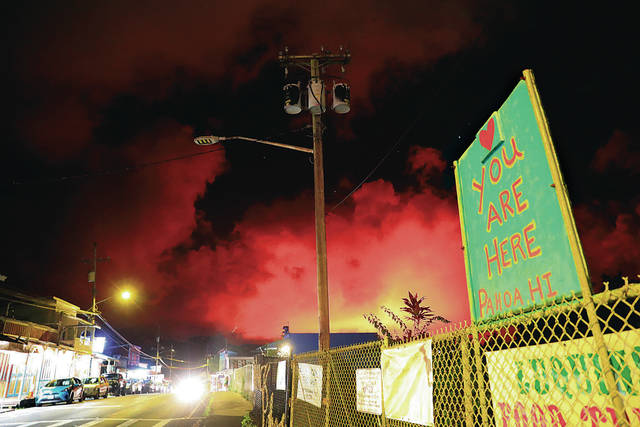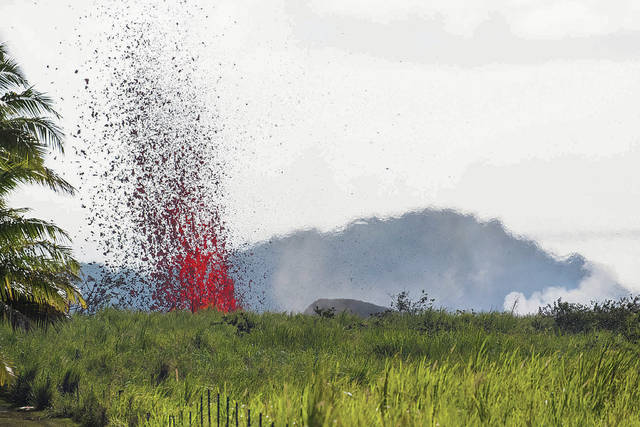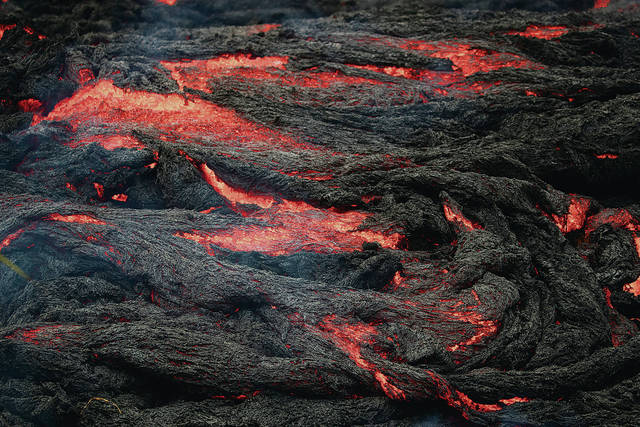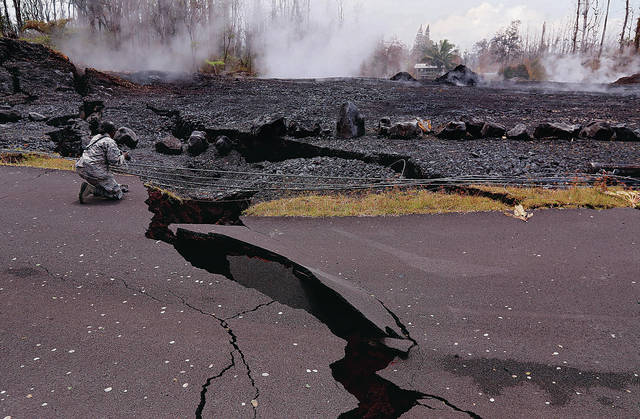4 rescued by helicopter as lava cuts off access to about 40 houses

JAMM AQUINO / JAQUINO@STARADVERTISER.COM
The night sky was illuminated by lava Friday in Pahoa.

CINDY ELLEN RUSSELL / CRUSSELL@STARADVERTISER.COM
Fissure 17 continued to erupt Friday morning in the Kapoho area of Puna. As of Friday, 22 fissures were reported in the Kilauea Lower East Rift Zone.

CINDY ELLEN RUSSELL / CRUSSELL@STARADVERTISER.COM
Lava advancing in the Kapoho area of Puna on Friday.

JAMM AQUINO / JAQUINO@STARADVERTISER.COM
Tech Sgt. Alison Bruce-Maldonado of the Hawaii Air National Guard observed large cracks in the pavement on Kupono Street inside Leilani Estates in Pahoa on Friday.




HILO >>
The eruption of Kilauea Volcano entered its third week with a dramatic turn Friday as fast-moving lava spewed into an area southwest of Leilani Estates, isolating about 40 homes in a remote region.
Late Friday afternoon, lava from fissure 20 in Leilani Estates crossed Pohoiki Road near Malama Ki Place on its way to the Pacific Ocean, Hawaii County Civil Defense officials said. Four people were evacuated via helicopter Friday evening by county and National Guard helicopters, officials said, although it appears some may have remained in their homes.
Civil Defense urged people still in the area to stay or find a safe place and await further instructions. American Red Cross shelters at Pahoa Community Center, Keaau Community Center and Sure Foundation Church were available to those evacuating as they have been in recent days to affected residents.
Pohoiki Road is closed.
RELATED STORIES
Don't miss out on what's happening!
Stay in touch with breaking news, as it happens, conveniently in your email inbox. It's FREE!
>> HELCO webpage updates customers affected by eruption
>> PHOTOS: 22 fissures signify more magma activity, May 18
>> PHOTOS: Satellite before-and-after images show Kilauea’s devastation
>> GoFundMe campaigns for victims
>> Live webcam atop Halemaumau
COMPLETE KILAUEA COVERAGE
* Star-Advertiser volcano coverage
* Kilauea Volcano YouTube playlist
Residents from the Lower Puna communities from Isaac Hale Beach Park to Kalapana were told by Civil Defense to prepare for a voluntary evacuation in the event Highway 137, Kalapana-Kapoho Road, is threatened. That route was open as of 8 p.m., as was Highway 130, Pahoa-Kapoho Road.
Earlier Friday, officials reported that lava spattering out of fissures in Lower Puna was coming out stronger, faster and more dramatically than in the previous two weeks.
That development marked a major shift because over the first two weeks, lava activity was defined largely by slow oozing coming out of the fissures. Scientists said that’s because the lava was likely magma stored underground making its way onto the surface as a result of the fresh magma pressing down from Kilauea’s summit.
That changed overnight Friday.
—
For more information on the hazards of volcanic ash and vog, go to volcanoes.usgs.gov Opens in a new tab and vog.ivhhn.org Opens in a new tab.
—
Wendy Stovall, a scientist with the U.S. Geological Survey, said there was an increase in activity at several of the fissures in the Lower Rift Zone, with several of them erupting lava. She described fissures 17, 18 and 20 as “the most voluminous producers at this time” with others doing “minor spattering.”
A chemical analysis was done of lava emanating from fissure 21, Stovall said. “All signs indicate that we are now seeing magma that came down from the summit in Puu Oo entering the system. There’s only one sample so far; this is only a preliminary analysis, but it does seem like that’s what’s going on.”
The sample has a magma source that’s closer in composition to that found at the summit and Puu Oo, Stovall said. “That is telling us that it’s likely that the summit magma has now reached this area of eruption in the Lower East Rift Zone and that lava flows and potential spattering will become more voluminous in that area.”
As a result, she said, “We expect that this lava will continue to be erupted at the surface, and probably in more voluminous fashion.”
Other samples are being tested, and it takes about 24 hours for an analysis to be completed.
Hawaiian Volcano Observatory geologist Janet Babb said “there are considerable challenges to collecting these samples. … It’s difficult fieldwork right now with the fumes and the lava that is spattering, so we’re collecting samples as we can at different locations at different times.”
Babb said there were also some visual indications that the magma composition at the fissures was changing. “What we’re seeing, the magma coming down from Puu Oo is fresher, hotter magma,” she said. “The initial fissures were erupting very sticky, pasty lava, and it wasn’t moving very far, so it’s fresher, hotter magma. There is a potential that the lava flows can move with greater ease and therefore cover more area.
Stovall said there are different scenarios that could occur next, but the most likely is that “in the Lower East Rift Zone, because we believe that the summit magma has arrived, that indicates … that new magma is just going to continue to erupt through these fissures, and they will be producing more voluminous lava flows and additional spatter.”
Earthquake activity at the summit had decreased after two explosions Tuesday and Thursday but was gradually increasing again Friday.
USGS officials released radar images showing an enlargement of the summit eruptive vent on the floor of Halemaumau Crater to about 34 acres Thursday from 12 acres on May 5, two days after the eruption began.
The radar images also showed a darkening of the terrain south of Halemaumau, indicating an accumulation of ash, as well as the development of a small depression of about 15 acres along the east rim of the crater reflecting slumping of a portion of the rim toward the growing collapse pit on the crater floor, USGS officials said.
Fissures 21 and 22 developed Thursday and Friday within the Leilani Estates subdivision, where most of the activity has occurred, Civil Defense Administrator Talmadge Magno said.
A 40th structure was destroyed overnight Friday. While Hawaii County Civil Defense officials are not sure how many of the 40 are actually houses since the information is being found through aerial footage, Magno said they were certain the latest one destroyed was a house.
Hawaii News Now reported a 41st structure, also a house, burned Thursday.
For people still living in Lower Puna despite the urging by Civil Defense to evacuate, Magno said, the danger is not just that their houses may be inundated by the lava, but isolation due to access being cut off. “That’s the main thing that’s going to effect most folks,” he said.
Paving of Highway 137, Kalapana-Kapoho Road, was completed Friday morning, Magno said.
Star-Advertiser reporter Kevin Dayton contributed to this story.




